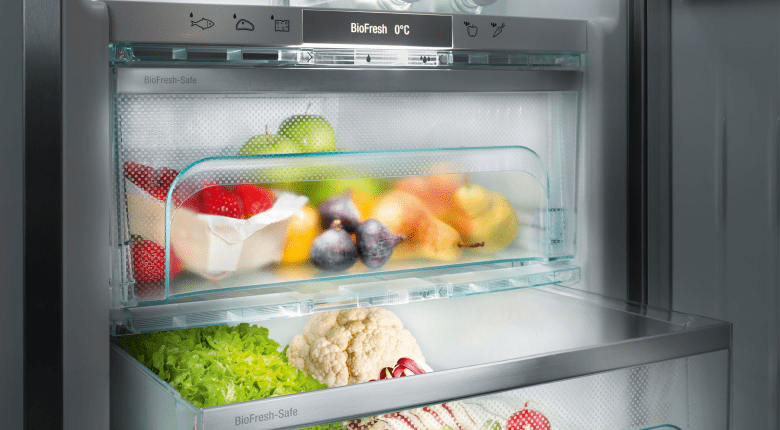Most of us don’t give a second thought when it comes to the best place to store food and drinks inside our refrigerator, so Liebherr have put together tips on the best way to utilise your refrigeration space, including the shelves and door compartments. We also highlight ‘what to’ and ‘what not to’ do.
Understanding your Liebherr refrigeration space a little better
The warmest area in the fridge is the door, so avoid storing dairy items along the door space. This area is best for items that can withstand fluctuations in temperatures due to frequently opening the door, items like condiments and juices. For many, we keep our milk in the door for easy access, if this is the case, the coolest part is the bottom door shelf.
The coolest part in the cavity of the fridge is the lower shelves and the rear, so when storing items such as dairy and raw meats, this is generally the optimum location. To prevent potential bacteria spreading between food types, keep your meat in a sealed container or wrapped up. Meat is best kept separate, so if you have a separate drawer or compartment suitable for meats, that’s even better for optimum refrigeration storage.
Storing tips for your Liebherr refrigeration space
Use metal, glass, aluminium or recyclable plastic containers if you are storing food with strong odours (such as marinades) or liquids. This will help minimise taste transfer and restrict potential exposure to other foods. Although cling wrap can be used, it doesn’t quite contain food odours as well as a sealed container does. Cling wrap should be for short-term.
Creating the right environment for your foods
It is recommended to activate functions such as SuperCool & SuperFrost prior to the grocery shop to assist with cooling new foods more rapidly. SuperCool & SuperFrost reduce the temperatures to +2°C and -32°C respectively and assist with excessive temperature increases to the items already in the fridge, while the door is open.
The right humidity is vital to correct food storage. In BioFresh drawers (0°C) low humidity is ideal for storing dairy, fish and meat, while HydroBreeze with high humidity, suits vegetables and fruit. Selected vegetables and fruits such as zucchini, avocado and pineapple, are sensitive to cold thus should not be stored in a BioFresh compartment, unless you have a BioFreshPlus drawer set at 6°C.

Liebherr vs the food life cycle
There is an agent in the food ripening process called ethylene gas, which some fruits and vegetables can omit in large doses. If stored with ethylene sensitive vegetables and fruits it will fasten the ripening process. Top refrigeration space tip: Where possible it is important to store the different types separately (ethylene sensitive foods vs high ethylene gas foods) with sensitive foods stored in the lower drawer (as gasses rise).
Examples of high ethylene foods are: Apple, Apricot, Avocado, Banana, Fig, Honeydew, Mango, Nectarine, Passionfruit, Pawpaw, Peach, Pear, Plum, Rockmelon, Tomato.
Examples of ethylene sensitive foods are: Artichoke, Asparagus, Beans, Broccoli, Brussel sprouts, Cabbage, Carrot, Cauliflower, Celery, Corn, Cucumber, Gooseberry, Greens, Endive, Shallot, Lettuce, Parsley, Potato, Rhubarb, Silverbeet, Squash, Sweet Potato, Zucchini.
Additional factors we should be mindful of when storing our foods
– Good air circulation requires space between the foods in the fridge.
– Make sure warm or hot food always reaches room temperature before placing in the freezer or fridge.
– Always rejig your fridge or freezer to make way for new food and warm items. Where possible it is best not to sit warm or fresh foods on top of cooled items already in the fridge or freezer. Cooled and already frozen items will be less affected by temperature variances.
– If you buy in bulk to freeze for later, always make sure you freeze in portion sizes that will make it easier and quicker to defrost. By storing in flat, compact arrangements, items will defrost more evenly and faster. Flat containers or zip lock labelled with the food type and date of purchase are a great way to freeze portions.
– Most importantly, think logically when you store your food. Regularly used items are often best front and centre, easily accessible. Excluding products where the recommendation is to store in the rear and lower shelving of the fridge where the temperature is always the coolest, such as dairy products.
Remember, the key is to shop smarter when it comes to food.
Don’t for get to let us know your tips on how you get the best from your refrigeration space on our social media pages!